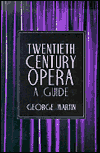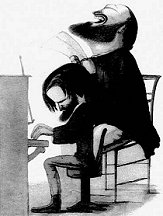Twentieth
Century Opera, A Guide
(NY: Limelight Editions, Paper, 1999)
ISBN 087910-275-6
"This gutsy, useful book, first published in 1979, has
been revised and expanded to include the developments of the
last quarter-century. Among its joys are Martin's Introductory
essays... [He]is an excellent explicator of music and story."
(Synopses of 90 Operas) Jennifer Howard, The Washington
Post. |



|
|



|
The Opera Companion, A Guide for the Casual Opera-Goer
(N.Y.:Amadeus Press, an imprint of Hal Leonard
Corporation, Paper, 2008)
ISBN 978-1-57467-168-1
A classic reference book for opera lovers, whether devoted
or casual, and the best introduction for beginners. The book
explains the techniques of opera in chapters on the overture,
melody, aria, and recitative, with a description of the human
voice as both an artistic and mechanical instrument. It also
includes a short history of opera, told chiefly in terms of
the audience and its behavior, synopses of forty-seven of
the most frequently performed operas and an amusing and informative
operatic glossary.
"Amusing and instructive... quite unlike any other kind
of opera book." Harold Rosenthal, former editor of Opera
“Skillfully fashioned... all very practical and sensible.”
The Financial Times.
"Considerate
sense and perception ... well expressed and instructive ...
goes out of its way to make the ingredients of a performance
clear and palatable." Times Literary Supplement.
|
Opera at the Bandstand, Then and Now
(scarecrow Press, 2014)
ISBN 978-0-8108-8853
This book has two related themes. One is the role of concert bands in the nineteenth and early twentieth centuries in making contemporary opera popular; the other, how in the latter half of the twentieth century the abandonment by concert bands of that operatic repertory was in part responsible for their loss of audience. In conclusion the book pleads for a revival of interest among bands in operatic excerpts for the good of both bands and opera.
The book is without precedence. Curiously, neither band nor opera buffs have examined the subject. Nor have critics, and for them at least one reason clearly is snobbery. They consider concert bands inferior to orchestras, seldom review them with care, and some critics have and do judge opera to be the most debased form of music. Yet opera continues to flourish. Why then do concert bands in their programs ignore what is currently the best of it?
The question is raised, the themes are displayed, in accounts of representative bands from each generation, starting with the Dodworth bands in New York City in the 1850s, the American tour of Mons. Jullien, the Jubilees of Gilmore, the Sousa era, 1892-1932, the Goldman band, 1920-2005, and finally the wind ensembles sparked by Frederick Fennel. Multiple appendices expose the bands’ repertories, and the Bibliography lists recordings of works often mentioned.
It should be stressed: This book is not a history of all concert bands, but a discussion of typical operatic repertories. For example, in the days before radio Rossini’s William Tell Overture became well known not from performances in an opera house, for it was an expensive opera to stage, but through constant playing by bands.
Similarly, Sousa, though certainly the “March King,” programmed a great deal of opera, presenting it often with vocal soloists and sometimes introducing the excerpt before the opera’s United States premiere. And New York’s Seventh Regiment Band performed an excerpt from Verdi’s Otello before that opera premiered. Remarkably, all this seems to be untilled soil in both operatic and band history. Hence the Book.
|


|

|
|

